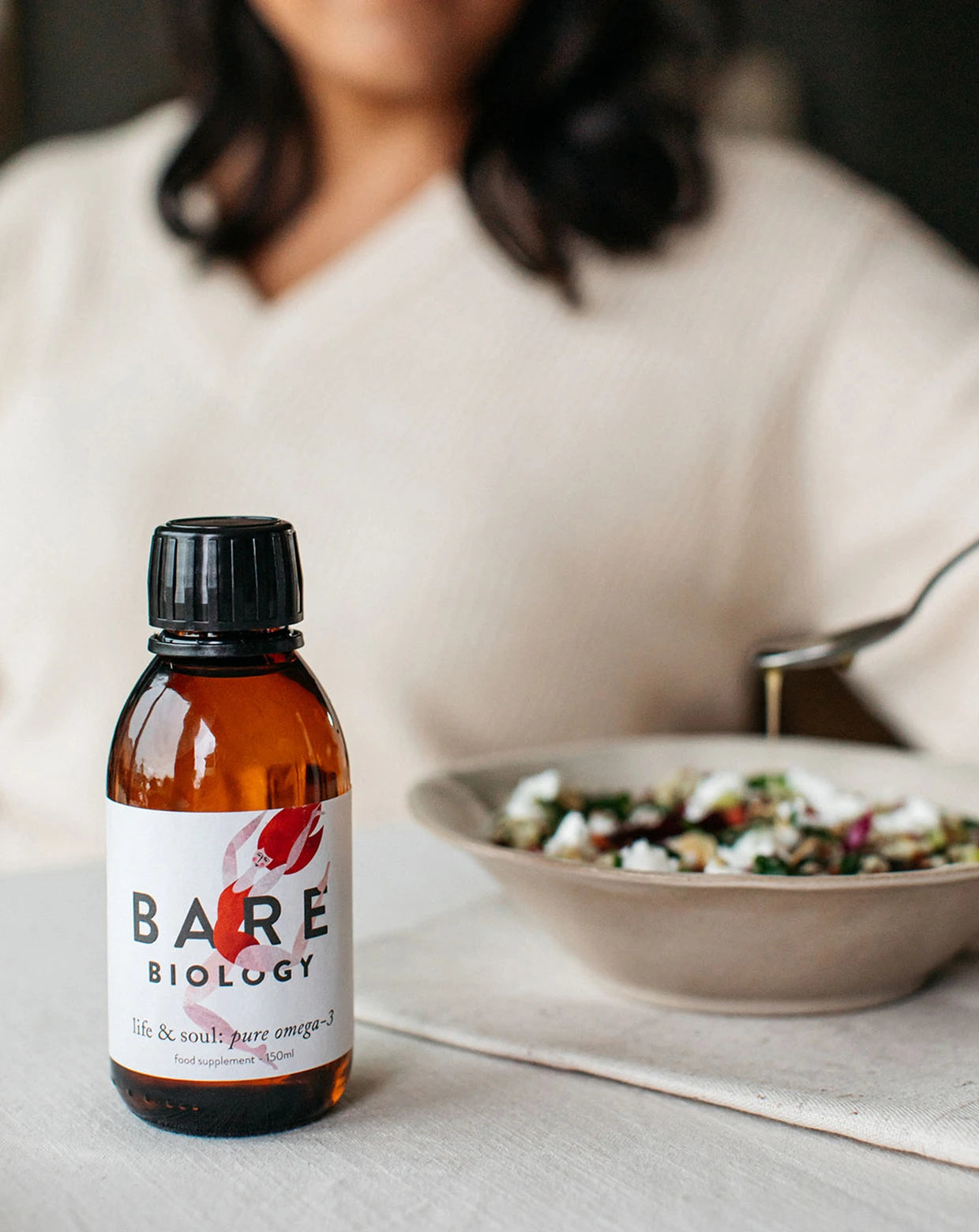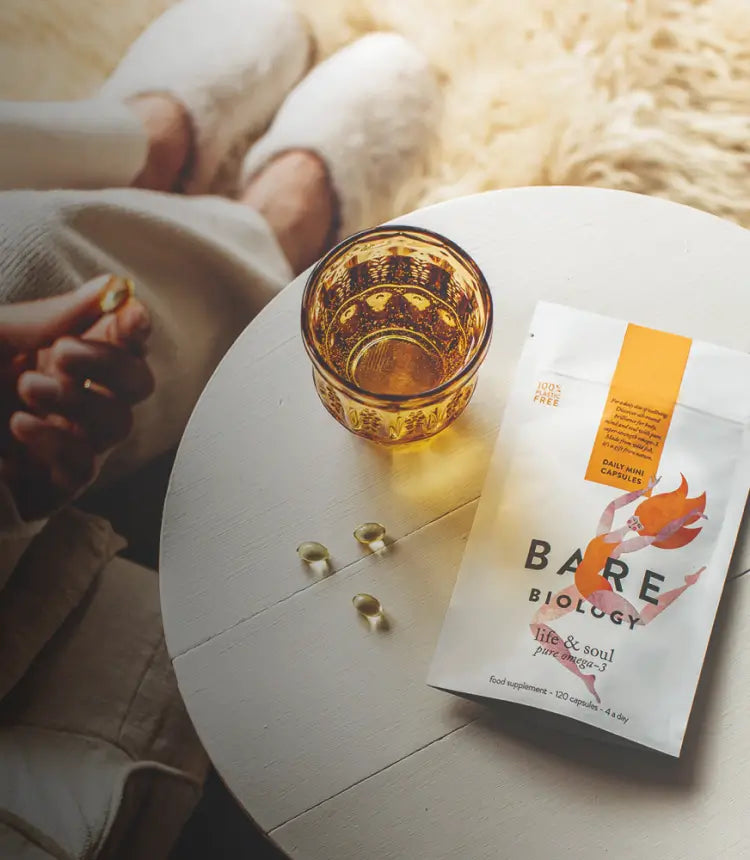Can you take evening primrose oil and fish oil together?
CONTENTS
Does evening primrose oil contain omega-3?
What is the difference between fish oil and evening primrose oil?
Should we be taking an omega-6 oil such as evening primrose at all?
The case for taking an omega-6 fat such as evening primrose oil
Can you take omega-3 and evening primrose oil together?
What’s the perfect evening primrose oil and fish oil combination?
Who shouldn’t take omega-3 fish oil and evening primrose oil together?
If your collection of vitamins and dietary supplements is starting to rival the shelves at your local health food shop, you may be wondering how all these active ingredients are interacting with each other in your body. Could some of the supplements you’re taking cancel out the effects of the others?
Well, there is some truth in that, because nutrients don’t ‘fly solo’ in the body. Some (like vitamin D and calcium) join forces, working in tandem to help the body. But others (like calcium and iron) jockey for position on the same metabolic pathways, effectively cancelling each other out.
Then there’s evening primrose oil and fish oil. One is an omega-6 fat, the other is rich in omega-3. But does that make them a dynamic duo, working together to give you double the health boost? Or will one undermine all the good work done by the other? And if so, should you be taking them separately, or at all?
Let’s have a look at the facts on omega-3 and evening primrose oil to find out.

What is evening primrose oil?
The evening primrose plant isn’t actually a primrose at all. It’s a member of the willow herb family with yellow flowers that open in the evening. Accidentally brought to Europe from North America in the 1600s, it became known as 'King's cure all' because of the wide range of problems it was used to treat, from skin disorders and wounds to hemorrhoids.
Completely edible, the famous oil is made from its tiny round seeds and you can buy it as pure oil or in capsule form. One of the biggest benefits of evening primrose oil is that its active ingredient is a type of omega-6 called gamma-linoleic acid (GLA). While omega-6 is already prevalent in our modern diets (and probably something we should be taking steps to reduce), the GLA form isn’t readily available.
This activated form of omega-6 is hard to come by in our diets but has its own role to play in our health. GLA is converted into DGLA (dihomo-gamma-linolenic acid) in our bodies, which nourishes cells and soothes inflammation.
What is omega-3 fish oil?
Made from the bodies (as opposed to the livers) of oily fish such as anchovies, sardines and mackerel, the raw fish oil is concentrated and purified so that you get more omega-3 per dose.
An essential fatty acid, the omega-3 from fish oil contains high amounts of the active ingredients EPA and DHA, both of which are essential for good health, but in short supply in our diets.
EPA (which stands for eicosapentaenoic acid) keeps our cells nourished and healthy, while DHA (docosahexaenoic acid) is most famous for the role it plays in the brain, where it’s used to form much of the structural material of our grey matter, from cell membranes to neurons.
Does evening primrose oil contain omega-3?
No. Evening primrose oil is purely an omega-6 fatty acid and contains no omega-3, EPA or DHA at all. The active ingredient in evening primrose oil is called GLA, which has health benefits of its own and is frequently used by people suffering from breast pain, PMS symptoms or skin conditions.



What is the difference between fish oil and evening primrose oil?
Both evening primrose oil and fish oil contain essential fatty acids, but while evening primrose oil falls under the heading of omega-6, fish oil is an omega-3.
Omega-6 and omega-3 are both necessary for good health but cannot be made by the body. Instead, we need to get them from our diets and, in balanced amounts, they complement each other perfectly.
While omega-6 increases inflammation (very important when it comes to your immune system), helps your blood to clot and cells to proliferate, omega-3 does the opposite. They both work in tandem to keep the body in check.
The problem is we’re already consuming far more omega-6 than we need. Whereas once the balance was something like 1:2 omega-3 to omega-6, now it’s more like 1:15 in omega-6’s favour, and can even be as high as 1:25 if you eat a poor diet.
Omega-6 is found in vegetable oils and because this kind of fat is cheap and has a long shelf life, it’s hard to escape. You’ll find it in virtually all processed foods, such as crisps and biscuits, but it’s also lurking in healthier sounding options like granola and hummus. We cook with it at home, restaurants cook with it when we’re out, it’s in our supermarket-bought salad dressings – the list goes on.
To make matters worse, our consumption of omega-3 has gone down, tipping the balance still further. We find it hard to eat even the weekly recommended amounts of fish due to concerns over contaminants.
Meat, dairy and eggs used to be brimming with omega-3 when cows were grass-fed and chickens free to roam. Now our cows are fed on grain, our chickens are raised on corn and both are routinely given antibiotics to fight off the diseases caused by intensive farming methods.
Most of us find it hard to get enough omega-3 in our diets to meet the daily recommended amounts for general good health, around 250-500mg per day, let alone go anywhere near balancing the amounts of omega-6 we’re getting. The result does not add up to good health, for either our brains or our bodies.

Should we be taking an omega-6 oil such as evening primrose at all?
We eat far too many omega-6 fats, that much is clear. For most people, their intake of omega-3 needs to go up, while the amount of omega-6 they’re eating should go down. So with that in mind, should anyone be taking an omega-6 rich supplement such as evening primrose oil at all?
The answer is, not all omega-6 fats are created equal. Omega-6 has largely been grouped together, regardless of the source. But whole-food sources of omega-6, such as nuts, also come packaged with other nutrients like fibre, polyphenols, magnesium, vitamin E and more.
Not only does this make them much more healthy, but the antioxidants are also useful in keeping the unstable omega-6 fats from being oxidised and turned into harmful free radicals.
But what really sets evening primrose oil apart from processed vegetable oils is its active ingredient, GLA. Despite the high amounts of omega-6 we’re getting in our diets, GLA is hard to find. The body can make GLA out of another omega-6 fat called linoleic acid (LA). But some people find this hard to do and we’ll explain exactly why that is below.
The case for taking an omega-6 fat such as evening primrose oil
In our diet, the most commonly consumed omega-6 fatty acid is arachidonic acid (AA). It’s found in high amounts in meat, eggs and dairy products, because of the grain-fed diet the animals are now consuming. While you need AA for muscle growth, brain development and maintaining a healthy nervous system, we’re all getting too much of a good thing. In excess, AA can promote inflammation.
Alongside this, we’re also eating high amounts of another omega-6 fatty acid called linoleic acid (LA) because it’s found in vegetable oils, butter and seeds. Usually, LA is digested and converted into GLA, which is a good thing because its anti-inflammatory effects can counterbalance the more inflammatory AA.
However, when we have too much AA in our body, it stops LA from converting into GLA. When LA is not converted to GLA this can be a problem, as the amount of pro-inflammatory AA and anti-inflammatory GLA is then out of balance.
Because of this, an excess of AA caused by a diet high in grain-fed meat, eggs and dairy can lead to some people being deficient in GLA.
The bottom line is the body needs GLA and most of us in the West are probably not getting enough of it, hence the need to consume a GLA-based supplement such as evening primrose oil.

While there’s no harm in taking both at the same time, it makes sense to time your evening primrose and omega-3 fish oil supplements so that you take them separately, to maximise the absorption of both.
Can you take omega-3 and evening primrose oil together?
Both omega-3 fish oil and evening primrose oil are beneficial, and complementary, providing the body with essential nutrients it may not be able to access from the food we’re eating. But should you take them at the same time or separately?
While it’s perfectly safe to take the two together (and some products even combine them into one evening primrose oil plus omega-3 fish oil capsule), there is a case for taking them at a different time of day.
The reason is simple. Both omega-3 and omega-6 share the same metabolic pathway. This means that both fish oil and evening primrose oil will compete for the same enzymes that are required to convert them in a way they can be metabolised and absorbed by our cells.
By taking evening primrose oil and omega-3 at separate times, you may improve the bioavailability of both supplements. By splitting up the dose, you’ll be providing the body with manageable amounts of both omega-3 and GLA throughout the day, ensuring the maximum absorption of all the active ingredients they contain.
Doing so may also help your digestion, protecting you against side effects such as tummy upsets if you’re already prone to them. So if you take your omega-3 fish oils in the morning, the best time to take evening primrose oil is in the evening, or vice-versa.

What’s the perfect evening primrose oil and fish oil combination?
By taking a Bare Biology supplement you know you’ll be getting a good daily dose of omega-3 fish oil. For example, the approved health claim for omega-3 by the EFSA (European Food Safety Authority) for normal blood pressure is 3,000mg of EPA and DHA. Our Life & Soul Omega 3 fish oil is the only product on the market that gives you this dose of omega-3 in just a single spoonful.
Evening primrose oil isn’t available on prescription, but isn’t expensive and can be bought in pharmacies. However, if you were taking it for something such as breast pain, it’s important you take an adequate dose. It is thought that a daily dose of GLA should be 240mg. Read the label on your supplement to see how much GLA it contains because, to achieve that, you may have to take several capsules.
Check that your evening primrose oil doesn’t contain any additional vitamins (such as vitamin A) because if you end up taking more than one capsule it could mean you’re exceeding that vitamin’s daily recommended dose. If you’re not sure about the supplements you’re taking, it’s a good idea to get medical advice from your GP.

Introducing
Who shouldn’t take omega-3 fish oil and evening primrose oil together?
Both evening primrose oil and omega-3 fish oil shouldn’t be used by anyone taking blood-thinning treatment like warfarin or aspirin.
While fish oil is fine for expectant mothers, evening primrose oil isn’t advised as there is a small risk of miscarriage with GLA. It should also be avoided by people with epilepsy.
Product Feature
LIFE & SOUL
So should I take evening primrose oil with omega-3 fish oil?
While it is an omega-6 fatty acid, which is something that we’re usually told to avoid, evening primrose oil GLA isn’t widely available to us from our day-to-day diets. In that way evening primrose oil actually works well with your fish oil, as both have properties that will keep your cells healthy and nourished.
While there’s no harm in taking both at the same time, it makes sense to time your evening primrose and omega-3 fish oil supplements so that you take them separately, to maximise the absorption of both.
If you’re still worried about evening primrose oil affecting your balance of essential fatty acids, it’s worth remembering the amount of omega-6 you’ll be getting per evening primrose oil supplement is negligible. It’s far better to look at the bigger picture and find ways to decrease your amount of omega-6 and up your amount of omega-3 in your diet by eating more oily fish or taking a pure, fresh supplement like Bare Biology.
You can read more about how all the Omegas work together in our omega-3, 6, 9 differences guide.

